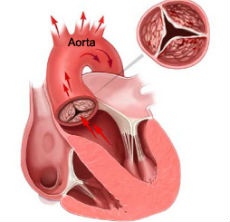Transcatheter Aortic Valve Replacement
Up to 1.5 million people in the United States suffer from aortic stenosis, a progressive disease that causes narrowing or obstruction of the aortic valve.
TAVR - Bringing Cutting-Edge Treatment to Cincinnati
At the TriHealth Heart & Vascular Institute, we are proud to be one of the first hospitals in the United States – and one of four in Ohio – to offer transcatheter aortic valve replacement (TAVR), a minimally invasive treatment option for those who are not candidates for open heart surgery or for whom surgery might have increased risk.
Symptoms of Aortic Stenosis
Patients who suffer from severe symptomatic aortic stenosis often develop debilitating symptoms that can restrict normal day-to-day activities, including:
- Severe shortness of breath
- Chest pain or tightness
- Fainting
- Extreme fatigue
- Lightheadedness/dizziness
- Difficulty exercising
- Rapid or irregular heartbeat
Patients with aortic stenosis can often benefit from surgery to replace their diseased valve, but only about two-thirds of them undergo the procedure each year. Many patients are not treated because they are not a candidate for surgery, have not received a definitive diagnosis, or because they delay or decline the procedure for a variety of reasons.
TriHealth Paving the Way in Heart Care
 Building on our reputation as leaders in cardiac care, TriHealth is one of the first hospitals in the United States to treat patients with transcatheter aortic valve replacement (TAVR).
Building on our reputation as leaders in cardiac care, TriHealth is one of the first hospitals in the United States to treat patients with transcatheter aortic valve replacement (TAVR).
Benefits of Transcatheter Aortic Valve Replacement
We take a multidisciplinary approach to care, meaning our team of surgeons, cardiologists and specialists work collaboratively to deliver optimal outcomes for our patients. TAVR, offered specifically at Good Samaritan, provides a state-of-the-art treatment option for adult patients who are not candidates for traditional open-heart surgery or for whom surgery might have increased risk. TAVR boasts a variety of benefits, including:
- Long-term survival within adults
- Proven symptomatic relief and improved quality of life
- A minimally invasive treatment option for quicker recovery
Prior to the advent of TAVR, there was no definitive treatment option for inoperable patients, as these patients are unable to undergo surgical aortic valve replacement (AVR) therapy – the gold standard treatment for most adult patients with severe aortic stenosis. Studies show that without an AVR, 50 percent of patients with severe AS will not survive more than an average of two years after the onset of symptoms.
How Transcatheter Aortic Valve Replacement Works
The TAVR procedure enables the placement of a collapsible aortic heart valve into the body via a catheter that is inserted through a small incision in the leg, and threaded up to the heart.
The valve is designed to replace a patient's diseased native aortic valve without traditional open-heart surgery and while the heart continues to beat – eliminating the need for cardiopulmonary bypass.
As with any significant procedure, TAVR may not be appropriate for every individual. Always ask your doctor about all treatment options, as well as their risks and benefits. In addition, the longevity of the valve's function is not yet known.
Illustration and animation courtesy of Edwards Lifesciences